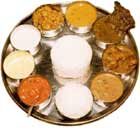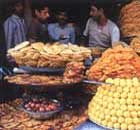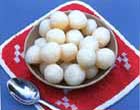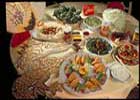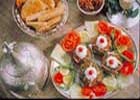Indian food is not only rice and curry. Indian cuisine is diversified in its varieties similar to its cultures, races and regions. There are innumerable variations of dishes prepared in the different parts of the country. In Europe curry means “a dish of meat, fish or vegetables cooked with bruised spices. What is understood by curry may have a number of variations across the country. The common factor across the country is that it is a gravy prepared with different spices.
The curry powder is the subtle and delicate blending of spices such as turmeric, cardamom, ginger, coriander, nutmeg, poppy seed etc. Depending on the dish what he/she is going to prepare an Indian cook has several spices (freshly ground as required) with which to mix and make the masalas. Many of these spices are noted for their medicinal values and are also used as appetisers and digestive. The ingredients for the masala vary from region to region. It is not true that all Indian dishes are hot. The “hot curry” is due to the use of chillies. If you are not used to “sharp and hot food” while ordering your food ask them to make it mild or extra mild.
Indian food is renowned for being aromatic and delicious. The basic Indian meal will have dishes of vegetable, fish, chicken or mutton served with rice. In the North you will have a range of Indian breads to choose from. The food will be served with a number of vegetable side dishes and curd/yoghurt. There are regional specialities which will replace some of the dishes as thousands of variations are available across the country. As the Hindus do not eat beef and Muslims do not eat pork, you may not find both as a common dish. Buffalo meat is available and mutton mentioned in the menus is from lamb.
Not all Hindus are vegetarians. But vegetable dishes, especially in South India are more common than in some parts of the North. Generally meat dishes are more common in the North.
Mughal cuisine is a great culinary tradition of India and originated in the courts of the Mughal emperors and is meat based. It is creamy, deliciously spiced and liberally sprinkled with nuts and sometimes with saffron. The well-known tandoori dishes (chicken, meat or fish marinated in herbs and baked in a clay oven) and kebabs also belong to the North Indian kitchen.
In the South, curries are mainly vegetable and inclined to be more spicy. Coconut is a major ingredient of southern Indian cooking. On the west coast there is a wide choice of fish and shellfish: Mumbai duck is not a meat curry but a fish curry. Bengal is famous for its fish dishes.
One main difference in north and souhth Indian food is that, whereas in the south rice is the staple food, in the north this is supplemented and sometimes substituted by a wide range of flat breads, such as Pooris, Chapatis and Nan. Common throughout India is Dal (crushed lentil soup with various additional vegetables), and Dahi, the curd or yoghurt, which accompanies the curry.
Variaties of sweets representing the style and taste of different regions are available in India. The main ingredients of the sweets and desserts are sugar, milk flour and ghee.
There is an abundance of fresh fruits.In some parts of India it is common to finish the meal by chewing pan as a digestive. Pan is a betel leaf in which are wrapped spices such as aniseed and cardamom.
Tea(or chai) is India's favourite drink. In the south it is coffee. Tea and coffee come ready with milk and sugar.
Bottled water is sold everywhere in India, but make sure the bottles are properly sealed.
Alcohol is not served everywhere. In almost all big cities in India certain days in the week are observed as dry days when the sale of liquor is not permitted. For up-to-date information please contact the India Tourism office.
If you would like get your favourite Italian or Chinese dishes, you will get it in most of the big cities.
Photos by courtesy of Indian Tourism, Amsterdam.



